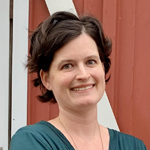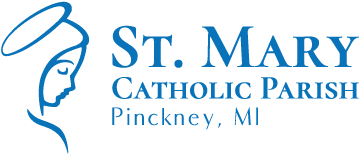O God,
by whose mercy the faithful departed find rest,
look kindly on your departed veterans who gave their
lives in the service of their country.
Grant that through the passion, death, and resurrection of your Son
they may share in the joy of your heavenly kingdom
and rejoice in you with your saints forever.
We ask this through Christ our Lord.
Author: WebDept ParishAdmin
Where is the Kingdom of Heaven? / ¿Dónde Está el Reino de los Cielos?
We live in a “both/and” Church, rather than “either/or”. Jesus is both true God and true man. Mary is both virgin and mother. We believe in Jesus’ death and resurrection. The Church is both the spotless bride of Christ and still a human institution prone to human failings and weaknesses.
Jesus presents another “both/and” in today’s Gospel. “The behold, the Kingdom of Heaven is among you.” And, “The days will come when you will long to see one of the days of the Son of Man, but you will not see it.” How can the Kingdom of Heaven be among them yet they will long to see it? The disciples did not fully understand, and we are still living in this mystery today.
At Mass, we experience a foretaste of the heavenly banquet. We are surrounded by the angels and saints who have gone before us and as we receive Christ, we are transformed more perfectly into His Mystical Body. At that moment, we are living in the Kingdom of Heaven to the fullest extent we are capable of on this earth. Yet at the same time, we know that this earth is not our permanent home. We long for the day when suffering will cease, when we will be free of our sin and sorrow. We will finally come home to the joy and rest of the Father and the true lordship of the Son of Man.
The world will try to call us away, to look here or there for the meaning of life. Jesus is reminding us that we already know where the Kingdom of Heaven is. It is by His side.
Vivimos en una Iglesia de “ambos/y”, en lugar de “uno u otro”. Jesús es verdadero Dios y verdadero hombre. María es virgen y madre. Creemos en la muerte y resurrección de Jesús. La Iglesia es tanto la novia sin mancha de Cristo como una institución humana propensa a las fallas y debilidades humanas.
Jesús presenta otro “ambos/y” en el Evangelio de hoy. “El Reino de Dios ya está entre ustedes”. Y, “Llegará un tiempo en que ustedes desearán disfrutar siquiera un solo día de la presencia del Hijo del hombre y no podrán”. ¿Cómo puede el Reino de los Cielos estar entre ellos y aún así anhelan verlo? Los discípulos no entendieron completamente, y todavía estamos viviendo en este misterio hoy.
En la Misa experimentamos un anticipo del banquete celestial. Estamos rodeados por los ángeles y los santos que nos han precedido y a medida que recibimos a Cristo, somos transformados más perfectamente en Su Cuerpo Místico. En ese momento, estamos viviendo en el Reino de los Cielos al máximo de lo que somos capaces en esta tierra. Sin embargo, al mismo tiempo, sabemos que esta tierra no es nuestro hogar permanente. Anhelamos el día en que cesará el sufrimiento, cuando seremos libres de nuestro pecado y dolor. Finalmente volveremos a casa al gozo y al descanso del Padre y al verdadero señorío del Hijo del Hombre.
El mundo tratará de distraernos para que busquemos aquí o allá el sentido de la vida. Jesús nos está recordando que ya sabemos dónde está el Reino de los Cielos. Está a Su lado.
 Kate Taliaferro is an Air Force wife and mother. She is blessed to be able to homeschool, bake bread and fold endless piles of laundry. When not planning a school day, writing a blog post or cooking pasta, Kate can be found curled up with a book or working with some kind of fiber craft. Kate blogs at DailyGraces.net.
Kate Taliaferro is an Air Force wife and mother. She is blessed to be able to homeschool, bake bread and fold endless piles of laundry. When not planning a school day, writing a blog post or cooking pasta, Kate can be found curled up with a book or working with some kind of fiber craft. Kate blogs at DailyGraces.net.
Feature Image Credit: fauxels, www.pexels.com/photo/man-and-woman-holding-hands-3228726/
St. Leo the Great: Saint of the Day for Thursday, November 10, 2022
Saint Leo the Great, also known as Pope Saint Leo I, was born into a Roman aristocratic family. His response to the call of the Lord transformed him into one of the greatest popes of Christian history. In fact, he was the first pope to be given the title “the Great.” Details pertaining to Leo’s place of birth are not known, but it is believed his ancestors come from Tuscany.
St. Leo the Great became a very well-known deacon of the Church by 431, serving the church under the pontificate of …
God is In Control / Dios Tiene el Control
Why is it that the more anxious we are, the more we cling to our vices? As each day brings us closer and closer to my husband’s surgery next week, I find myself getting into the kids’ Halloween candy more and more. If I just indulge in one little pleasure, if I just have a little more sugar in my body, maybe I’ll feel better or more in control.
The problem is, the effect is just the opposite. It only causes my thoughts to accelerate, my joints to be cranky and my body to be more sluggish, not to mention the extra pounds I am surely packing on.
The guest priest said in his homily last weekend that prayer is what we most need to get closer to God, yet it is often the first thing we push away. When we have a lot to do, the first thing we discard is our prayer time. Why is that? When we feel like we are in survival mode, do we consider it nonessential? As I am typing this I realize even more what an oxymoron that is! What is more essential than God himself? Without Him we wouldn’t even be here!
When will we learn that the only way to be in control is to let go and let God be in control..?
Yet it appears as if Jesus has lost control in today’s Gospel. We see him driving out vendors with a whip and overturning the money changers’ tables. This is perhaps the one place in Scripture where we see Him in a true display of righteous anger… “and to those who sold doves he said, ‘Take these out of here, and stop making my Father’s house a marketplace.’”
I remember recalling this passage while visiting Ireland several years ago. A country that has such a rich Catholic heritage (mostly thanks to St. Patrick), is falling away from the faith little by little. Several of their majestic churches have either been sold to Protestants or are now tourist hubs. It was the strangest thing to walk into a beautiful church and see booklets, maps and trinkets. It truly felt like a marketplace.
And perhaps, as we allow ourselves to succumb to our vices and shove prayer aside, we are allowing a noisy marketplace to rise up in our hearts. And what does Jesus want to do? He wants to “whip us into shape” so to speak, and overturn the tables of our false expectations.
God truly is in control, that is, He will be, if only we let Him…
¿Por qué cuanto más ansiosos estamos, más nos aferramos a nuestros vicios? A medida que nos acercamos más y más a la cirugía de mi esposo la próxima semana, me encuentro cada vez más agarrando los dulces de Halloween de his hijos. Si solo me permito un pequeño placer, si solo tengo un poco más de azúcar en mi cuerpo, tal vez me sienta mejor o con más control.
El problema es que el efecto es todo lo contrario. Solo hace que mis pensamientos se aceleren, que mis articulaciones estén irritables y que mi cuerpo sea más lento, sin mencionar los kilos de más que seguramente estoy acumulando.
El sacerdote invitado dijo en su homilía el fin de semana pasado que la oración es lo que más necesitamos para acercarnos a Dios, pero a menudo es lo primero que rechazamos. Cuando tenemos mucho que hacer, lo primero que descartamos es nuestro tiempo de oración. ¿Porqué? Cuando sentimos que estamos simplemente sobreviviendo, ¿lo consideramos no esencial? ¡Mientras escribo esto me doy cuenta aún más del oxímoron que es! ¿Qué es más esencial que Dios mismo? ¡Sin Él ni siquiera estaríamos aquí!
¿Cuándo aprenderemos que la única forma de tener el control es dejar que Dios tenga el control?
Sin embargo, parece como si Jesús hubiera perdido el control en el Evangelio de hoy. Lo vemos expulsando a los vendedores con un látigo y volcando las mesas de los cambistas. Este es quizás el único lugar en las Escrituras donde lo vemos en una verdadera muestra de ira justa… “y a los que vendían palomas les dijo: ‘Quiten todo de aquí y no conviertan en un mercado la casa de mi Padre’”.
Me acuerdo de haber pensado en este pasaje cuando visité a Irlanda hace varios años. Un país que tiene una herencia católica tan rica (sobre todo gracias a San Patricio), se está alejando de la fe poco a poco. Varias de sus majestuosas iglesias han sido vendidas a protestantes o ahora son centros turísticos. Fue de lo más extraño entrar a una hermosa iglesia y ver folletos, mapas y regalitos de recuerdo. Realmente se sentía como un mercado.
Y tal vez, al permitirnos sucumbir a nuestros vicios y dejar de lado a la oración, estamos permitiendo que un mercado ruidoso se levante en nuestros corazones. ¿Y qué quiere hacer Jesús? Quiere encaminarnos y derribar las mesas de nuestras expectativas falsas.
Dios verdaderamente tiene el control, es decir, lo tendrá, si tan solo se lo entregamos…
 Tami Urcia grew up in Western Michigan, a middle child in a large Catholic family. She spent early young adulthood as a missionary in Mexico, studying theology and philosophy, then worked and traveled extensively before finishing her Bachelor’s Degree in Western Kentucky. She loves tackling projects, finding fun ways to keep her little ones occupied, quiet conversation with the hubby and finding unique ways to love. She works at for Christian Healthcare Centers, is a guest blogger on CatholicMom.com and BlessedIsShe.net, runs her own blog at https://togetherandalways.wordpress.com and has been doing Spanish translations on the side for over 20 years.
Tami Urcia grew up in Western Michigan, a middle child in a large Catholic family. She spent early young adulthood as a missionary in Mexico, studying theology and philosophy, then worked and traveled extensively before finishing her Bachelor’s Degree in Western Kentucky. She loves tackling projects, finding fun ways to keep her little ones occupied, quiet conversation with the hubby and finding unique ways to love. She works at for Christian Healthcare Centers, is a guest blogger on CatholicMom.com and BlessedIsShe.net, runs her own blog at https://togetherandalways.wordpress.com and has been doing Spanish translations on the side for over 20 years.
Feature Image Credit: Brett Jordan, unsplash.com/photos/JZUAigW8Kbo
St. Benignus: Saint of the Day for Wednesday, November 09, 2022
Bishop of Ireland, the son of Sechnaa, the psalm singer of St, Patrick. Sechnan was a chief in Meath, Ireland, converted by St. Patrick. Benignus became a disciple of St. Patrick and succeeded him as the chief bishop of Ireland. He converted the Irish in Clare, Kerry, and Connaught. Benignus served as the superior of an abbey at Drumlease, erected by St. Patrick.
Evening Prayers: Prayer of the Day for Wednesday, November 09, 2022
The following form of evening prayers is taken from “The Key of Heaven, a Manual of Prayer for the Use of the Faithful”, Imprimatur P. Fenton, Vicar General, Westminster.
In the Name of the + Father,
and of the Son,
and of the Holy Ghost.
Amen.
O my God,
I believe that Thou art here present;
and that Thou observest all my actions,
all my thoughts,
and the most secret motions of my heart.
I adore Thee,
and I love Thee with my whole heart.
I return …
Tuesday of the Thirty-second Week in Ordinary Time
Reading 1 Ti 2:1-8, 11-14
Beloved:
You must say what is consistent with sound doctrine,
namely, that older men should be temperate, dignified,
self-controlled, sound in faith, love, and endurance.
Similarly, older women should be reverent in their behavior,
not slanderers, not addicted to drink,
teaching what is good, so that they may train younger women
to love their husbands and children,
to be self-controlled, chaste, good homemakers,
under the control of their husbands,
so that the word of God may not be discredited.
Urge the younger men, similarly, to control themselves,
showing yourself as a model of good deeds in every respect,
with integrity in your teaching, dignity, and sound speech
that cannot be criticized,
so that the opponent will be put to shame
without anything bad to say about us.
For the grace of God has appeared, saving all
and training us to reject godless ways and worldly desires
and to live temperately, justly, and devoutly in this age,
as we await the blessed hope,
the appearance of the glory of the great God
and of our savior Jesus Christ,
who gave himself for us to deliver us from all lawlessness
and to cleanse for himself a people as his own,
eager to do what is good.
Responsorial Psalm 37:3-4, 18 and 23, 27 and 29
R. (39a) The salvation of the just comes from the Lord.
Trust in the LORD and do good,
that you may dwell in the land and be fed in security.
Take delight in the LORD,
and he will grant you your heart’s requests.
R. The salvation of the just comes from the Lord.
The LORD watches over the lives of the wholehearted;
their inheritance lasts forever.
By the LORD are the steps of a man made firm,
and he approves his way.
R. The salvation of the just comes from the Lord.
Turn from evil and do good,
that you may abide forever;
The just shall possess the land
and dwell in it forever.
R. The salvation of the just comes from the Lord.
Alleluia Jn 14:23
R. Alleluia, alleluia.
Whoever loves me will keep my word,
and my Father will love him,
and we will come to him.
R. Alleluia, alleluia.
Gospel Lk 17:7-10
Jesus said to the Apostles:
“Who among you would say to your servant
who has just come in from plowing or tending sheep in the field,
‘Come here immediately and take your place at table’?
Would he not rather say to him,
‘Prepare something for me to eat.
Put on your apron and wait on me while I eat and drink.
You may eat and drink when I am finished’?
Is he grateful to that servant because he did what was commanded?
So should it be with you.
When you have done all you have been commanded, say,
‘We are unprofitable servants;
we have done what we were obliged to do.’”
– – –
Lectionary for Mass for Use in the Dioceses of the United States, second typical edition, Copyright © 2001, 1998, 1997, 1986, 1970 Confraternity of Christian Doctrine; Psalm refrain © 1968, 1981, 1997, International Committee on English in the Liturgy, Inc. All rights reserved. Neither this work nor any part of it may be reproduced, distributed, performed or displayed in any medium, including electronic or digital, without permission in writing from the copyright owner.
Order Up! / Ya Está Lista la Orden
Today’s readings can be a bit harsh; however, it is all laid out for us. We are essentially given a good examination of conscience in the First Reading, followed by a good reminder of our goal, what lies ahead for those who follow God’s law.
Living the Christian life is about more than just following a set of commandments, though. It’s about living a life in relationship with God, the same God who awaits us in Heaven. Eternal life with God in Heaven will be the fulfillment of all our desires, most of which we cannot imagine at this point in our lives. But we do know that all of the desires we experience here on earth ultimately point to our eternal life in Heaven, and so we should work to order those desires to God now.
Let’s take social media. The hours (yes, hours) a day we spend on our phones is quite alarming, as we can truly scroll our lives away, and that’s exactly what the social media companies want us to do. We scroll because we haven’t quite found what we were looking for – we’re left wanting more. More likes, more comments, more shares, more videos, more, more, more. We’re never truly satisfied, always left unfulfilled.
That is because our desires are ultimately directed toward Christ and only He can truly fulfill them. One of St. Augustine’s most well-known lines from his Confessions is, “You have made us for yourself, O Lord, and our hearts are restless until they rest in You.” How true it is! For the likes and affection and affirmation we may be searching for on social media, are freely given to us by our Lord. We are loved, we are cherished, we are chosen by Him. That’s all we truly need in life, is to know how much we are loved by our God who created us, who became man for us and who died for us.
We should always keep our eyes fixed on Christ, who always fixes His eyes on us, who desires all of us to be in Heaven with Him one day and who wants to fulfill the longings of our hearts with His love.
Las lecturas de hoy pueden ser un poco duras; sin embargo, todo lo que dice nos encamina. Esencialmente se nos da un buen examen de conciencia en la Primera Lectura, seguido de un buen recordatorio de nuestra meta, lo que les espera a aquellos que siguen la ley de Dios.
Sin embargo, vivir la vida cristiana es algo más que seguir un conjunto de mandamientos. Se trata de vivir una vida en relación con Dios, el mismo Dios que nos espera en el Cielo. La vida eterna con Dios en el Cielo será el cumplimiento de todos nuestros deseos, la mayoría de los cuales no podemos imaginar en este momento de nuestras vidas. Pero sabemos que todos los deseos que experimentamos aquí en la tierra apuntan en última instancia a nuestra vida eterna en el Cielo, por lo que debemos trabajar para ordenar esos deseos a Dios ahora.
Hablemos po un momento sobre las redes sociales. Las horas (sí, horas) que pasamos todos los días en el teléfono son bastante alarmantes, ya que realmente podemos alejarnos de nuestras vidas, y eso es exactamente lo que las compañías de redes sociales quieren que hagamos. Nos desplazamos porque no hemos encontrado lo que estábamos buscando, nos quedamos con ganas de más. Más “likes”, más comentarios, más de mis anécdotas compartidas, más videos, más, más, más. Nunca nos quedamos verdaderamente satisfechos, siempre quedamos insatisfechos.
Esto se debe a que, en última instancia, nuestros deseos están dirigidos hacia Cristo y solo Él puede cumplirlos verdaderamente. Una de las frases más conocidas de San Agustín de su escrito Las Confesiones es: “Nos has hecho para ti, oh Señor, y nuestro corazón está inquieto hasta que descanse en ti”. ¡Qué cierto es! Porque los gustos, el afecto y la afirmación que podemos estar buscando en las redes sociales, nos los da nuestro Señor gratuitamente. Somos amados, somos apreciados, somos elegidos por Él. Eso es todo lo que realmente necesitamos en la vida, es saber cuánto nos ama nuestro Dios que nos creó, que se hizo hombre por nosotros y que murió por nosotros.
Siempre debemos tener los ojos fijos en Cristo, quien siempre fija Su mirada en nosotros, quien desea que todos nosotros estemos algún día en el Cielo con Él y quien quiere cumplir los anhelos de nuestro corazón con Su amor.
 Erin is a Cleveland native and graduate of Franciscan University of Steubenville. She is passionate about the Lord Jesus, all things college sports and telling stories and she is blessed enough to get paid for all three of her passions as a full-time youth minister and a freelance sports writer.
Erin is a Cleveland native and graduate of Franciscan University of Steubenville. She is passionate about the Lord Jesus, all things college sports and telling stories and she is blessed enough to get paid for all three of her passions as a full-time youth minister and a freelance sports writer.
Feature Image Credit: christian buehner, unsplash.com/photos/Krb1gqZd37o
St. Castorius: Saint of the Day for Tuesday, November 08, 2022
St. Castorius is the patron saint of sculptors and his feast day is November 8th. Castorius, Claudius, Nicostratus, and Symphorian are called “the four crowned martyrs” who were tortured and executed in Pannonia, Hungary during the reign of Diocletian. According to legend, they were employed as carvers at Sirmium (Mitrovica, Yugoslavia) and impressed Diocletian with their art, as did another carver, Simplicius. Diocletian commissioned them to do several carvings, which they did to his …
Take me from the dark: Prayer of the Day for Tuesday, November 08, 2022
Lord,
With your bright and open heart forgive me for showing darkness to the light.
Putting my back, to what is right was wrong and i have sinned against you.
Forgive me O merciful one because i have relished my wrong and i am sorry for what i have done.
Lord i am ready to contiue following in your footsteps.
Take my from the dark.
Hear me now O lord.
Amen


